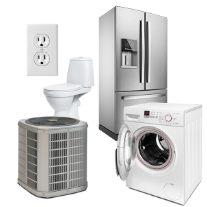Winter is on its way.
And along with thinking about switching from tank tops and flip-flops to sweaters and boots, it’s also time to switch up your thinking to ways to keep your home toasty all season long. So before the temperature drops below freezing, here is a short list of things you can do to keep the heat from escaping your home and your energy bills from ballooning beyond your budget.
Winterization doesn’t have to be hard or expensive
1. Is it drafty in here?
If cold air is rushing in beneath your doors or around windows, it’s time to stop it.
“Improving your home’s insulation and sealing air leaks are the fastest and most cost-effective ways to reduce energy waste and make the most of your energy dollars,” according to the U.S. Department of Energy (DOE).
One of the easiest things you can do to prevent air leaks is to place a draft snake at the base of your doors. You can buy one premade or you can make your own by simply rolling up a towel.
Another way to stop leaks is to wrap your windows. All it takes is some heavy-duty clear plastic, which you can buy in a kit at your local home improvement store, and a hair dryer. Or you can tape the plastic in place, just make sure it is sealed tightly. You also can tape bubble wrap in place to insulate your windows.
Insulated drapes or shades also can help keep the cold out and the heat in, as can caulking or weatherstripping around all windows and doors.
2. Find those leaks
Caulk, caulk and more caulk. In addition to caulking gaps around windows or doors, the DOE also recommends sealing air leaks around cut-throughs for pipes, chimneys, recessed lighting and spaces behind cupboards and closets. The DOE offers a list of ways to find your air leaks ranging from a home-energy audit to a simple visual inspection.
Another tip from the DOE is to shut a door or window on a dollar bill. “If you can pull the dollar bill out without it dragging, you’re losing energy.”
Make sure to keep your fireplace damper closed when not in use. And remove those window-unit air conditioners so cold air doesn’t sneak in.
3. Is your furnace in shape?
While it doesn’t have to run a marathon, it’s important that your heating system is in shape for the long haul of winter. Schedule a tune-up before the temperatures drop. And replace your filter once a month.
If you use a pellet- or wood-burning stove, make sure to clean your flue vent often using a wire brush.
And while you’re thinking furnace, think AC, too, and shut off the air conditioning water valve to prevent excess water from collecting in the equipment.
4. How’s your insulation?
Adding more or better quality insulation, whether it is batts or loose-fill or foam can really get your home bundled up for winter. If you aren’t sure what R value you need or where you should get insulated, check out pages 8-11 of this EnergySaver guide.
5. What about the plumbing?
If you live in a cold climate, your plumbing could be at risk to freeze and thaw (perhaps more than once) during the winter, which can cause pipes to burst.
Weatherproofing your plumbing is always a good idea. To do so, turn off the water supply to outdoor spigots, sprinkler systems, swamp coolers and AC units and drain them. If your AC or swamp cooler has components outside, make sure to cover them.
2-10 HBW offers the most comprehensive coverage for homeowners. Let us help you get started with a Home Warranty today!








